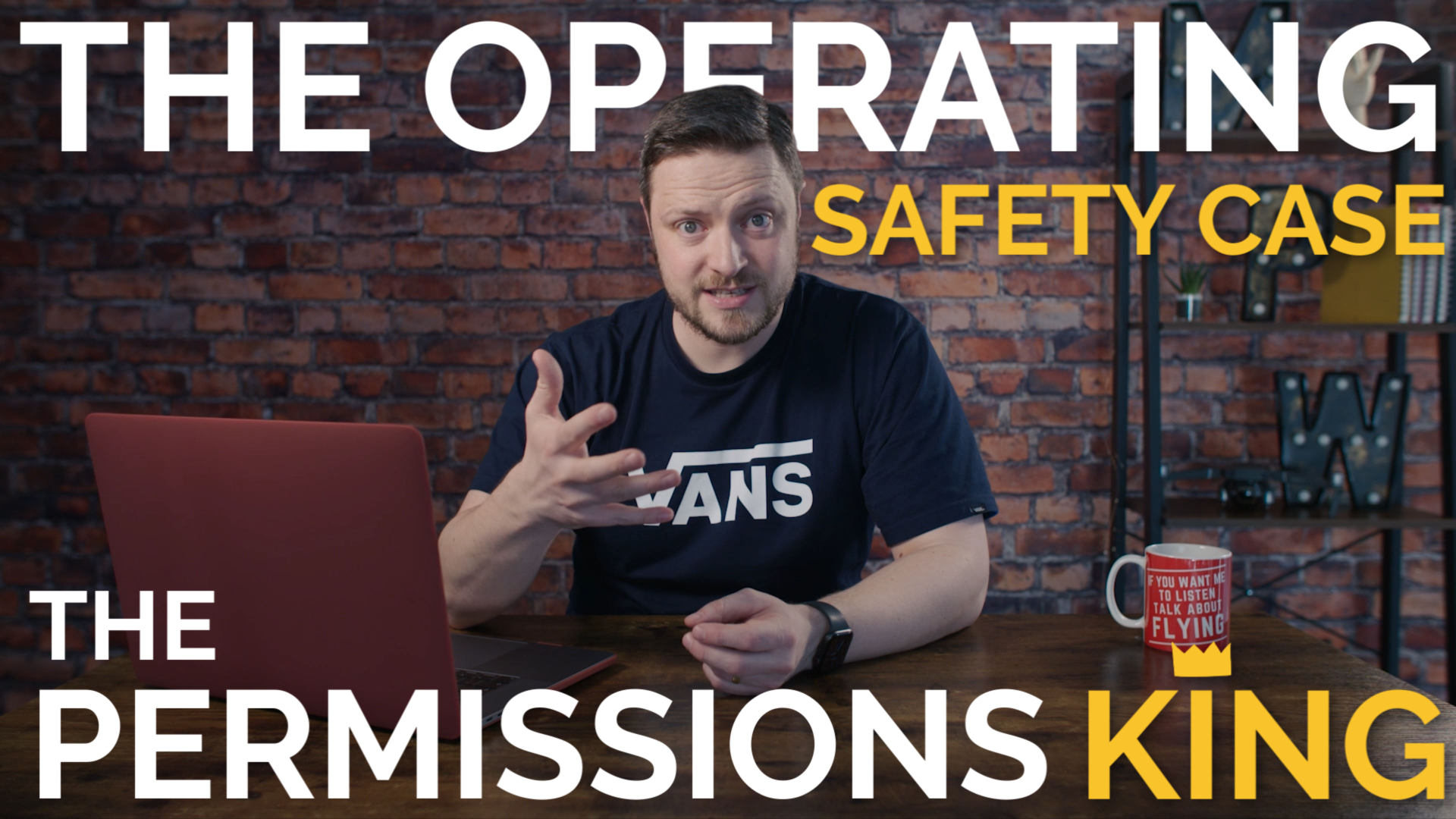
Is the CAA Operating Safety Case ( OSC ) the best CAA Drone Qualification you can get?
The CAA Operating Safety Case (or OSC as it has become known) system has been around pretty much since the CAA first started issuing permissions for people to fly their drones commercially in the UK but it's always been something of a mystery to many... Our aim is to demystify the OSC process!
We'll be covering this over a series of blogs articles and videos across the channel - so make sure you subscribe and stay tuned, to stay up to date with all the content as it arrives.
Read time approx 8 minutes
What is a CAA Operating Safety Case (OSC)?
The CAA Operating Safety Case (OSC) system allows commercial drone operators to get better permission for flying their drone than you can get under the standard permissions systems, such as the Permission for Commercial Operation (PfCO) or the new GVC (General Visual Line of Sight).
Traditionally, if a commercial drone operator wants to get closer than the usually allowed separation distances of 50 metres from uninvolved persons (or people not under control of the Remote Pilot), then the only way to do this is to have an Operating Safety Case in place, granted to them by the CAA which often reduces these separation distances down to 20, 10 or in some cases, even 5 metres.
There will be some crossover under the CAA GVC scheme eventually when the 'bolt-ons' for congested area flying become available but at the time of writing, it's looking like this could be between 3-5 years away. Not only do the CAA need to implement the new GVC system; they also need to create the risk-assessments which the congested area bolt-ons will utilise. In addition to the scheme being finalised, in order to operate under the new bolt-on permissions for congested area operations the permission holder will be required to fly new 'certified' drones for this purpose; which also don't exist yet!
We did expect that the OSC system would cease to exist when the new drone laws came into force in the UK in 2020... However, the CAA recently announced that the OSC system will be 'carrying on' past the implementation date, because of all the reasons mentioned above - there's simply no mechanism which exists yet, to allow people to get better drone flying permissions.
If it ain't broke - don't fix it... So, the OSC lives on! :)
Why should you get a CAA Operating Safety Case (OSC)?
There are many very good reasons why a commercial drone operator should consider getting an OSC from the CAA if they are capable of getting it and are able to afford the costs associated with getting an OSC approved by the regulator.
The first and most obvious reason for getting an Operating Safety Case is that it will allow you to operate and fly your drone in more places. By reducing the separation distances from people and buildings from the standard drone permissions; you'll be able to fly your drone where other people can't.
This isn't the only reason though - the best reason we've seen for people to get a CAA OSC is the marketing advantage which is associated with being able to stand out from the other 10,500 qualified drone operators in the UK! in such a competitive market, having a unique selling point is critical. Especially if you have the opportunity and wherewithal to leverage this as a marketing opportunity.
We often speak to people who have considered getting an OSC, who are put off by the fact that it takes a long time to create an OSC or costs a fair amount of money to get an expert to help you create one, because of the amount of time involved. The thing most people fail to realise though, it seems, is that by getting an OSC - you immediately position yourself in a place where there are only a small number of other operators.
Yes, the total cost of getting an OSC may be ~£5k by the time everything is said and done but when you consider that the baseline day rate for OSC operators tends to be £1000 (we used to charge a minimum of £1500 for OSC work), rather than the £300 - £350/ day which we see for standard permissions holders - the numbers begin to look rather favourable. In addition, the reduction in advertising spend which an OSC Drone Operator can expect to have to outlay in order to get work in will also reduce. You're no longer competing with all the other CAA Drone Permission Holders and qualified drone pilots... You're setting yourself out as an expert within your industry; meaning there's no longer a rush to the bottom on price and people will pay you which you are worth, based on your additional skills, expertise and the value you can deliver!
How do you get a CAA Operating Safety Case (OSC)?
The process for applying for a CAA Operating Safety Case has been shrouded in mystery since it's inception. People who have gained these OSC permissions have, quite rightly, wanted to keep the process quiet, because it's taken them a great deal of work to achieve and they're now reaping the rewards!
In essence, the OSC is a 3 volume set of documents which present to the CAA the ways in which you're able to operate safely, down to the separation distances which you're applying for.
There are 3 'volumes', or documents which make u an Operating Safety Case and all of the information for applying for an OSC can be found in the CAA CAP 722. The 3 volumes you'll be required to create are:
- Volume 1 - Operations Manual
- Volume 2 - Aircraft Systems
- Volume 3 - Safety Assessment
Most operators have a basic version of Volume 1; their Operations Manual, but most of the CAA Drone Operations Manuals that we've seen don't meet all of the requirements found in the CAP 722 for the OSC Operations Manual Volume 1. Definitely one to check before you submit your OSC Application to the CAA!
Once you've completed the 3 volumes to the CAA's guidelines, you'll need to complete a CAA Form SRG1320 and send all the documentation over to the CAA, who will then assess the application and decide what permissions to issue you with.
It's worth noting that unlike standard drone permission applications; there is no mandated time-frame for the CAA to respond to, review and/or issue OSC Drone Permissions to an operator. It can take a number of months from submitting your OSC application to the CAA, to receiving your OSC from the regulator... Another thing to factor in if you are thinking about adding this capability to your drone business!
Conclusion
The OSC process is now fairly well documented but is still kept largely shrouded in mystery by those who know how the system works!
An operating safety case can be a great tool to help you stand out from the crowd and definitely sets an OSC drone operator apart from the 'masses' of commercial drone operators who are currently in the industry. It'll help you to market yourself, physically help you to be able to operate your drones where other commercial drone pilots can't AND it'll allow you to increase your average 'day rate' massively.
If you want to know more about how to get an Operating Safety Case, we have a training course launching very soon that will walk you through the steps required and expose you to the ins and outs of creating and applying for a CAA OSC and we'll also be launching an 'OSC in a Box' product in the next few days, where the team and I will work with you to create a 'ready to go' OSC in just a few weeks!
To stay up to date make sure you sign up to the Mr MPW newsletter and to find out more about how we could help you get a CAA Operating Safety Case, drop us an email: matt@mrmpw.com.
Fly safe & blue skies,
Matt
Frequently Asked Questions
How do you apply for a CAA OSC?
The application process for a CAA Operating Safety Case is a little different to the application process for a standard CAA Commercial Drone Permission. Rather than using the online CAA Drone Permission portal, the OSC Applicant must use CAA Form SRG 1320 to apply for their OSC Permission to be reviewed.
How much does it cost to apply for and get an OSC with the CAA?
The current costs for getting an OSC are £1771 and the annual renewal costs are £506 each year. The charges for all CAA Drone Permissions can be found in the CAA ORS 5 - CAA Scheme of Charges (General Aviation)
How long does an Operating Safety Case (CAA OSC) last for?
Once you have been approved to operate under an OSC by the CAA, the permission lasts for 12 months (unless the CAA rescind the permission within that time-frame, for some reason, such as breaches of the conditions). You can then apply for a renewal of your CAA Operating Safety Case at a reduced rate, provided that you apply whilst your current OSC is still valid.
Leave a comment
Comments will be approved before showing up.
Also in Mr MPW Blog - Latest News, Articles and Updates from the Drone & Aviation World

Can you REALLY earn £65k as a Professional Drone Pilot?

How to start a Drone Training Company in the UK - Becoming a CAA RAE

